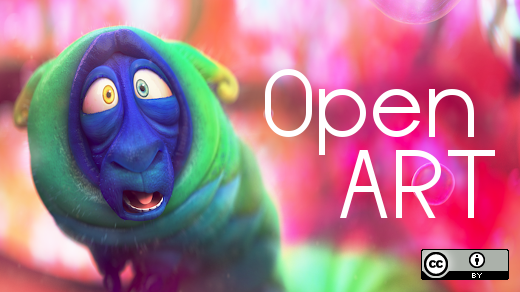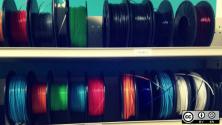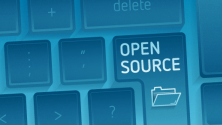The field of computer graphics has continued to prove itself as fertile ground for getting kids interested in code and technology. It isn't just about the extremely gratifying feeling of creating cool-looking visuals on a computer. Since so many digital content creation programs (especially open source ones like Blender) feature built-in scripting support, it's a natural avenue for fostering curiosity in code and software development.
This is exactly the kind of strategy and thinking behind the DigiVita Code Event and Summer Camp, an initiative from VHTO, the Dutch National Expert Organization on Girls/Women and Science/Technology. DigiVita code events are one-hour-long workshops designed to teach technology to young girls. At Blender Conference 2015, Lieke Boon from VHTO and Monique Dewanchand from At Mind gave an engaging presentation about their experiences in organizing and teaching these workshops. The half-hour presentation is available on the Blender Foundation YouTube channel, but you can watch it below.
Lieke and Monique kindly agreed to answer some additional questions about their workshops.

On the face of it, teaching Blender in an event meant for teaching code seems like a strange choice. Could you explain the rationale for this decision? Have you received any negative feedback (e.g. "Why are you teaching my kid about video games? I thought this was supposed to be about coding!")?
Lieke Boon (LB): Well, the most important thing about the code events is that girls explore the amazing world of technology. Most girls are active users of ICT (Information and Communication Technology) applications. We (VHTO red) want to encourage them to not just be consumers of technology, but to be creators of it as well. Blender is a perfect tool to let the girls be artists themselves (while using technology). The kids show their parents at the end of the day what they made and the parents love it. I think that's amazing. And no, never complaints—only from girls who wanted to continue when the workshop was over.
Monique Dewanchand (MD): As Lieke points out these code events are about getting girls acquainted with computer technology. In my humble opinion, 3D technology is an important area to explore as well. 3D technologies are rapidly evolving and are becoming part of our daily lives (3D printing, YouTube VR, Facebook 360, etc.). Kids are asking to learn about these technologies. I think that Blender as an open source 3D content creation suite fits perfectly because kids can do (almost) everything related to 3D in one tool. And they can easily explore other areas in the same tool using the same look and feel.
Also important, kids can continue learning 3D with Blender after these code events. Blender can be downloaded for free, and there are numerous tutorials online.
Negative feedback? On the contrary, kids and parents are super excited and are asking how to continue.
It's pretty amazing what these girls were able to accomplish with just a one-hour workshop. Are you aware of any students who have continued using Blender after it's all over? What kinds of cool things are they doing?
LB: Yes, and to be honest, most of the time the girls even had time left! So Monique did an amazing job with developing these exercises. There are some girls who have continued using Blender. I think Monique can tell you more about that. I know that Monique was pretty amazed by this and that's why we're looking for a platform to continue/follow up.
MD: Indeed, I was surprised to see how easily they could perform the tutorials and exercises. I know of some girls that have continued learning Blender. The majority is experimenting with modelling; creating an ice cream cone on a hot day, creating a dragon based on a model from Blend Swap. One girl is trying to learn how to rig. I am really amazed what they are exploring on their own.
However the majority of online tutorials seem to be too difficult for these kids. There is a need for simple, step-by-step tutorials for kids. This is something that I am currently working on.
The unique decisions in Blender's user interface are often highlighted in forums as a stumbling block for adoption by professionals. Did you run into any of these kinds of difficulties in your workshops? Did you make any changes to Blender to mitigate those issues?
MD: While creating these tutorials and exercises I did think that the UI was going to be a challenge. So I simplified the UI a bit by hiding some windows and features. But still it didn't look that easy. In the tutorials I clearly showed where they had to click or edit.
During the code events it didn't seem to be a problem. Those kids that continued on their own didn't complain about the UI. Yes they find the UI complex, but they were able to manage and create what they wanted to.
I must add that the majority of kids already had experience with computers and software.
What other workshops centered around open source technology are you offering or planning on offering?
LB: The Blender workshop was part of the DigiVita Code Event. So we also offered other workshops in Rails, Scratch, HTML/CSS and App Inventor (although I'm not quite sure of you can call App Inventor Open Source). We're planning to organise a workshop around Sonic-Pi, mostly because I just love it and I think it's a great tool to teach kids and teachers how to code. And the best part is that you can make music at the same time. What more do you want?
What's next for this program? Are there any plans to expand it to other parts of Europe or even other parts of the world?
LB: That would be awesome! Unfortunately, we're a non-profit organisation so we rely on funds and we're not able to organise all these events on our own. But for now we're planning to expand the Code Events to other cities in the Netherlands. In the Netherlands girls and women are highly underrepresented in computer science (CS) and information technology (IT)-jobs. Often because they have a limited view of the possibilities, have no female role models or think that IT is only for boys. Therefore VHTO launched DigiVita in January 2014, a national program to get more girls involved in CS. And that's why our main focus will be national (in the Netherlands). It would be great if we can expand it to other parts of the world. You never know, we can always dream big.
As for the Blender workshops. Monique and I are very excited to expand the workshops. We'd like to organize follow up meetings and we'd love to create a (online) platform for kids to go to when they want to continue learning Blender.
MD: Indeed it would be great to expand the Blender for kids workshops to other parts of the world! So I have started to create an online platform and some other tutorials and exercises on 3D and Blender. I hope to have something online soon. The tutorials and exercises will be freely available.
As Lieke points out, there is not much budget available. So I hope that others will join and help out in creating or sharing their tutorials and help to organise events so that we can teach kids about 3D and Blender.
What did you think of Blender Conference 2015?
LB: I have to admit: it was my first Blender Conference. I didn't know what to expect and it was one of the most fun and best conferences I've been to in my whole life (and believe me, I've been to a lot) . I think the Blender community is amazing and it was so much fun to be part of it. (And I could only join you for one day!)
MD: Haha! I think this was my 6th or 7th Blender Conference? And I wouldn't want to miss it.







5 Comments